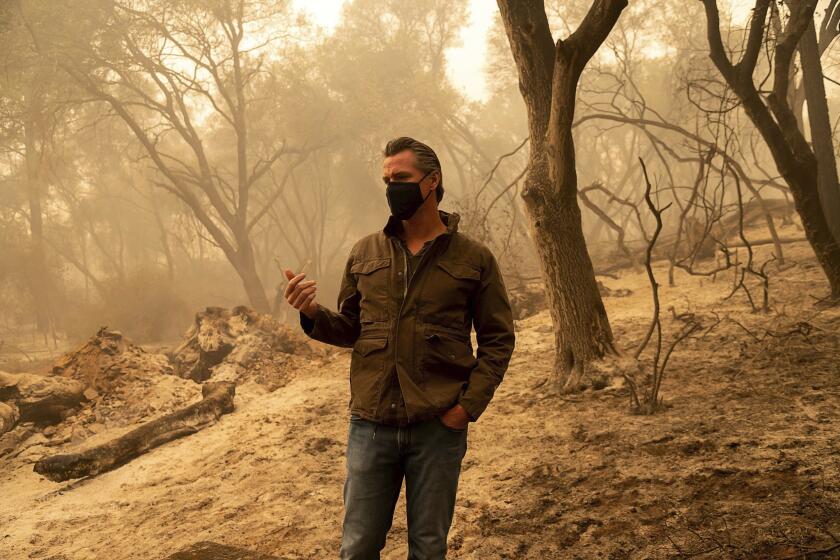The next Aliso Canyon could happen on L.A.’s Westside
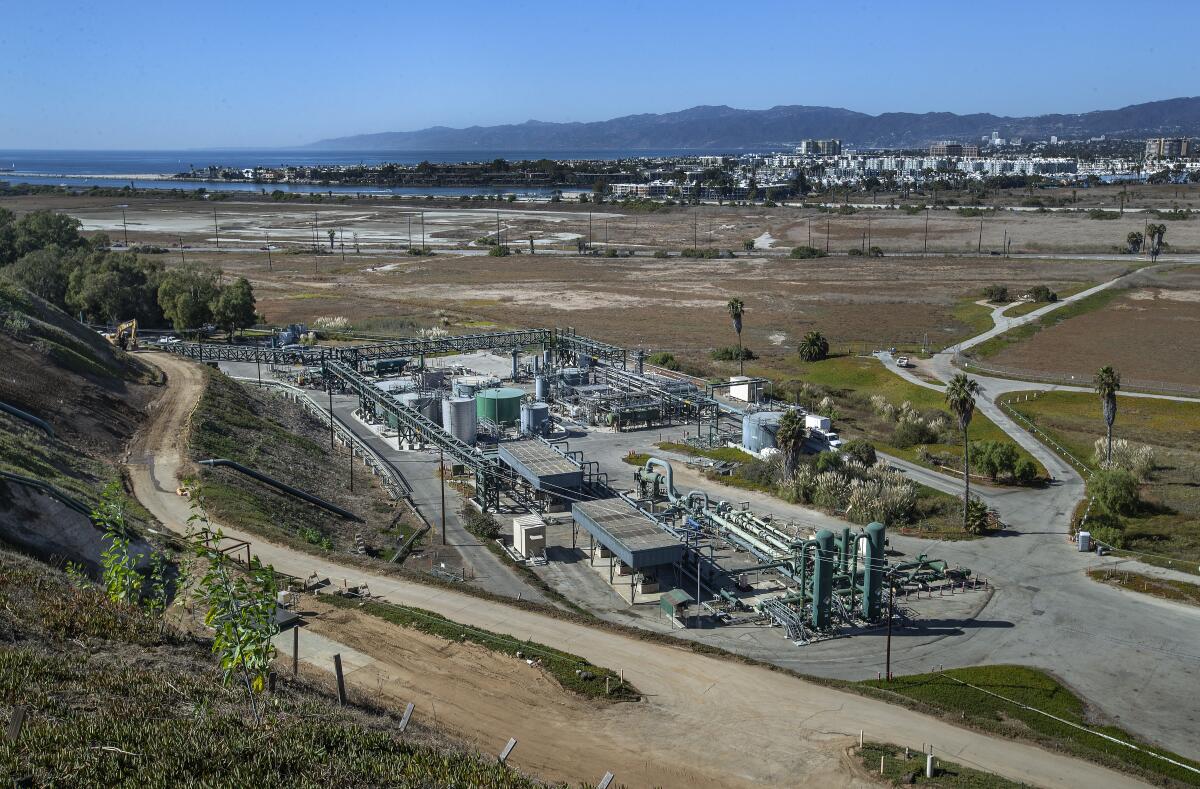
- Share via
The sludgy geyser of gas, water and mud startled residents of Marina del Rey.
The hissing plume reached 100 feet into the air, the product of a hotel developer’s failed attempt to re-plug a long-abandoned well from the Playa del Rey oil field. Video of the gusher showed a worker hurrying to lower himself to safety via escape rope.
The 2019 blowout was stemmed after 10 minutes but not before an estimated 100,000 cubic feet of powerful planet-warming natural gas escaped into the atmosphere, about what an average U.S. household would use in two years.
The geyser most likely spewed from a naturally occurring underground gas pocket, state officials concluded. But for Angelenos, it was a dramatic reminder of the legacy of fossil fuel extraction on the city’s Westside — a legacy felt to this day.
It’s been 80 years since the Playa del Rey field reached its zenith as an oil producer, and nearly as long since Southern California Gas Co., now the country’s largest gas utility, began storing a different fossil fuel there. The company pumps gas into a sandstone formation thousands of feet below ground when demand is low, then sucks it back out when demand is high, sending the fuel to power plants for electricity generation and homes and businesses for heating and cooking.
It’s the same type of operation as Aliso Canyon, another SoCalGas storage field that suffered a record-breaking leak in October 2015, sickening residents of L.A.’s Porter Ranch neighborhood and forcing thousands of people to evacuate.
The Playa del Rey facility is significantly smaller than Aliso. But by some measures, it poses a far greater threat.
Many more people live within a few miles of Playa than Aliso, meaning the health and economic consequences of a major blowout could be worse. The Westside storage field has older wells. And like Aliso, it has a long history of leaks.
SoCalGas insists both facilities are safe and critical to meeting local energy needs — especially on cold winter days when Angelenos turn up their thermostats and on hot summer days when gas plants generate electricity for air conditioners.
“The Playa del Rey storage facility supports the integration of renewable energy like solar and wind during unfavorable weather conditions, keeps customer bills affordable by allowing our region to buy and store natural gas when prices are low, and promotes a diverse energy mix,” SoCalGas spokesperson Christine Detz said in a written statement to The Times.
Those claims haven’t convinced environmental activist Marcia Hanscom, a leader of the campaign to close the storage field.
Hanscom lives in Playa del Rey and is intimately familiar with the neighborhoods surrounding the SoCalGas facility, from working-class Westchester to the upscale Playa Vista community. Los Angeles International Airport is a mile from the gas field.
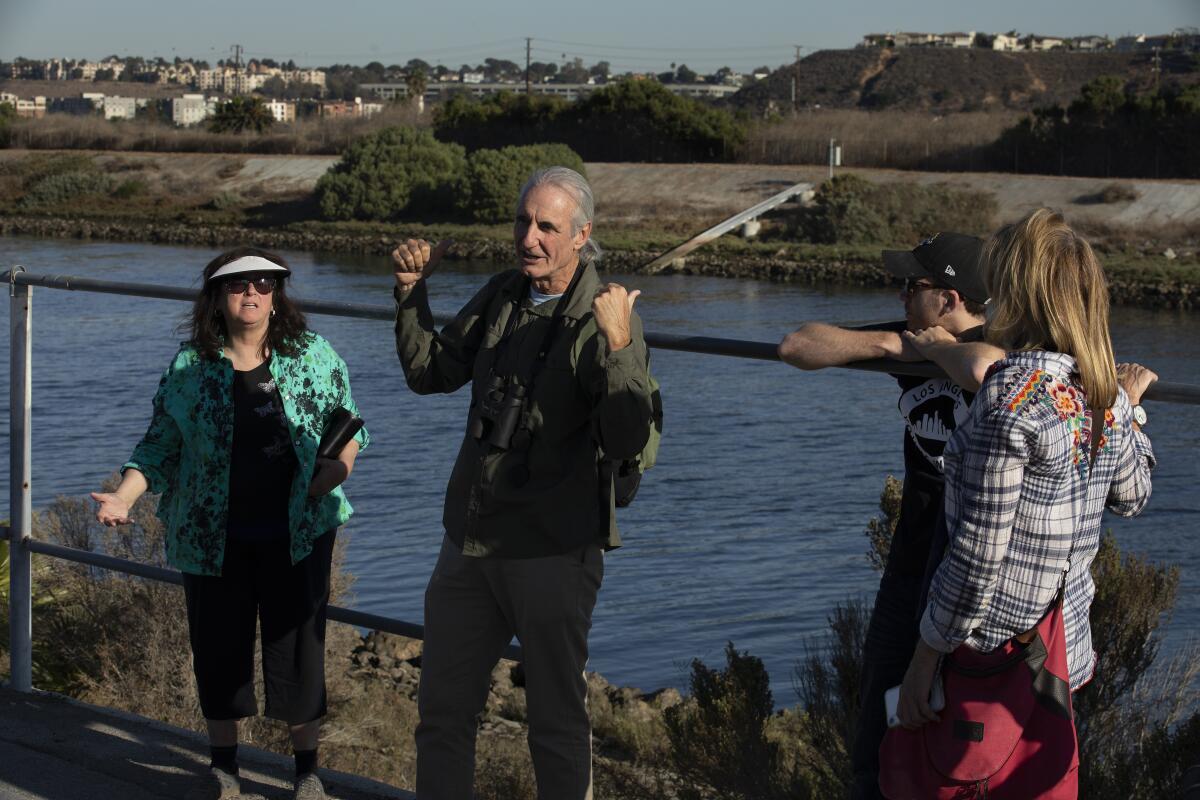
The gas storage field also lies directly beneath Los Angeles County’s largest remaining coastal wetlands, the Ballona Wetlands. Gas pipelines cross underneath Ballona Creek, which is parallel to the newly completed Park to Playa trail.
For Hanscom, protecting those communities is more than enough reason to shut down the facility.
“The bottom line is, we need to stop injecting gas into this field,” she said. “It’s just too dangerous.”
There’s growing support for that idea among elected officials. Los Angeles City Council unanimously approved a resolution from Councilperson Mike Bonin on Wednesday calling for the state to close the facility. Culver City Council approved a similar resolution. The L.A. County Board of Supervisors asked Gov. Gavin Newsom last year to study the feasibility of closing the storage field.
In a recent interview, L.A. Mayor Eric Garcetti expressed support for the activists campaigning to shut down Playa del Rey.
“I’d like to see that happen as quickly as scientifically supportable,” Garcetti said. “I think over time, those campaigns are just, and they’re right on about where we need to be, and also will help those lands be better preserved.”
Clean energy activists across the country are pushing cities and states to phase out natural gas, meeting intense opposition from gas utilities. The fuel burns more cleanly than coal but is still a significant contributor to the climate crisis.
Sempra Energy is seeking federal approval for a new proposal to ship fossil fuel overseas.
In Southern California, the campaign against gas kicked into high gear following the Aliso Canyon blowout, which took SoCalGas four months to get under control. The San Fernando Valley facility spewed 109,000 tons of methane into the atmosphere.
Playa del Rey has less than 3% of the gas storage capacity of Aliso.
But 45,000 people live within a mile of Playa del Rey, compared with just 6,500 within a mile of Aliso, according to a 2018 report from the California Council on Science and Technology, a nonprofit research organization established by state lawmakers.
Expand the boundary to five miles and almost half a million people live near the Westside gas field, more than twice as many as those who live near Aliso. And nearly 4,000 people live directly above the Playa del Rey field, compared with just 25 directly above Aliso.
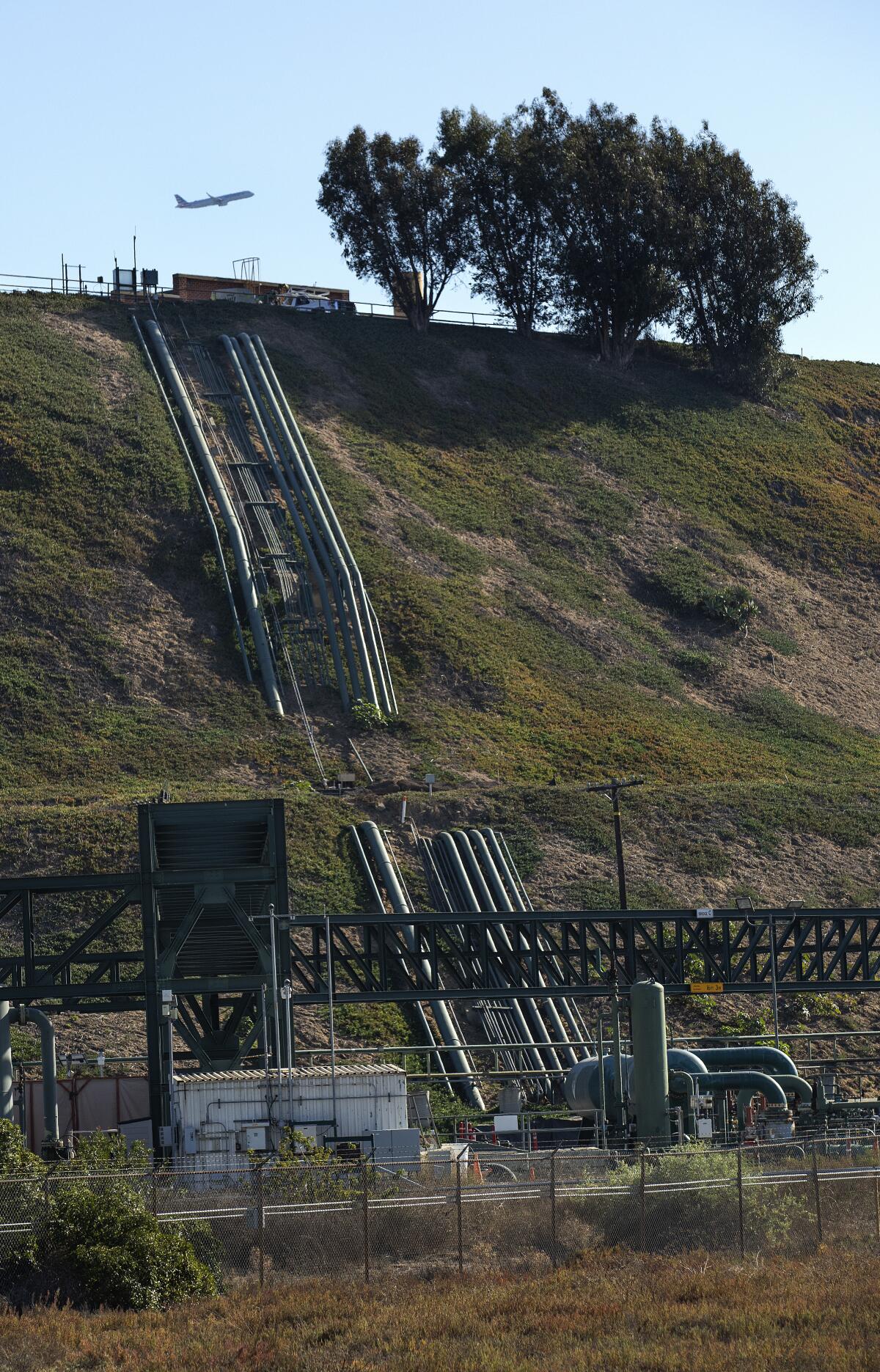
The council’s report noted that Playa del Rey had the oldest active wells of any California gas storage field, with a median drill date of 1935. It said the facility has a “record of [unplanned releases], is near a large population center, features tsunami and wildfire threats, and has a relatively small gas storage capacity.”
The gas field should be studied for potential closure, the council concluded.
SoCalGas and its parent company, Sempra Energy of San Diego, have every incentive to stop that from happening.
Sempra noted in a recent financial filing that public scrutiny of gas storage poses a risk to its business, citing lawmakers and activists who “have expressed a desire to further limit or eliminate reliance on natural gas.” The Fortune 500 company didn’t mention Playa del Rey specifically. But it warned that any “significant impairment” of Aliso Canyon — which activists also hope to see closed — could hurt its bottom line.
SoCalGas didn’t make any executives available for an interview. But company officials have described their four storage fields as among the safest in the country.
“Aliso Canyon is an event that we regret, but I think one of the outgrowths of Aliso Canyon is that it was an industry-changing event,” SoCalGas President Maryam Brown told the Rotary Club of Pasadena last week. “We worked very closely with our state as well as federal regulators to redesign Aliso Canyon, as well as our other storage facilities, to make them state of the art.”
Brown also cited the heat wave California experienced in August — which led to brief rolling blackouts as electricity demand outstripped supply on two consecutive evenings — as an example of why Los Angeles needs local gas storage.
“There was a very significant need for draw from storage to be able to ensure the reliability that we had,” she said.
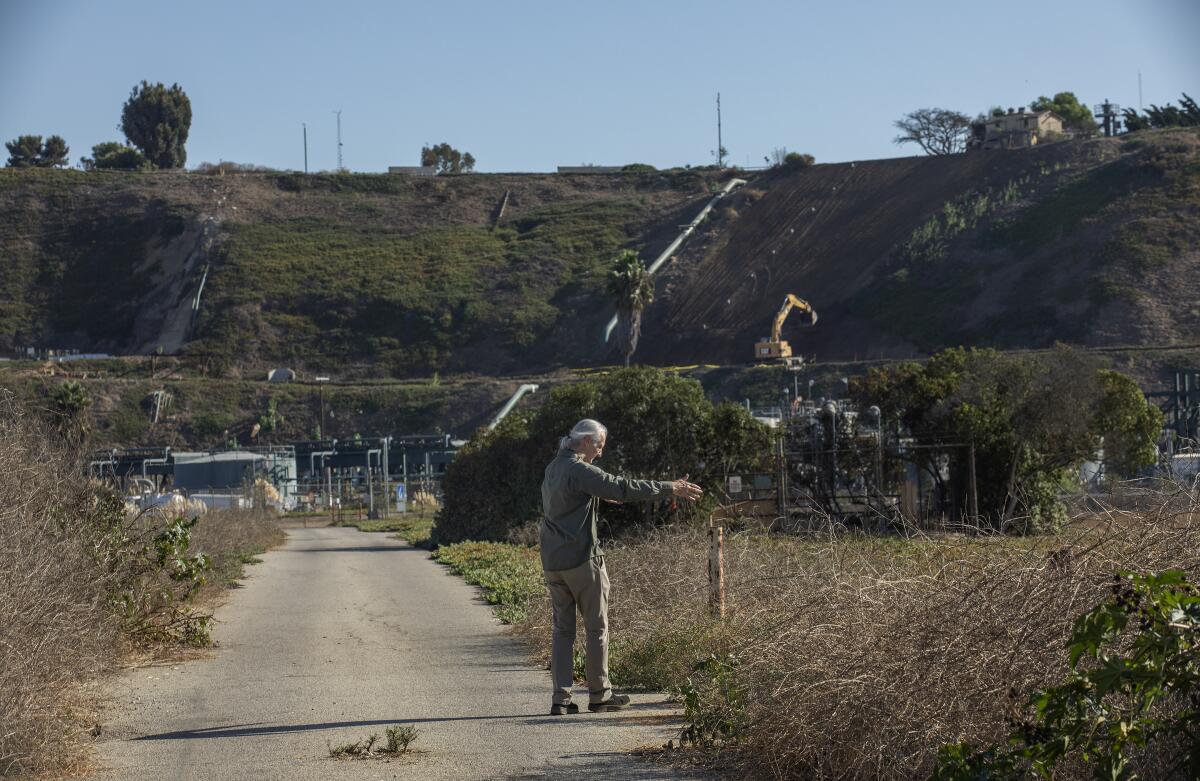
The gas company has been pressing those points on elected officials. In a letter to L.A. City Council members last month, Paul Goldstein, the utility’s vice president for transmission and storage, wrote that local power plants “were using far more gas than was being delivered through interstate pipelines” during the August heat wave. In a letter to a Culver City official in December, he wrote that the rolling blackouts “would have been much worse” without facilities such as Playa del Rey.
Those claims haven’t convinced climate activists, who want California to limit reliance on gas by switching to solar, wind and other clean energy sources. The Los Angeles Department of Water and Power released a study last month concluding the city can achieve 98% clean power by 2030 and 100% by 2035, with minimal economic disruption and no greater risk of blackouts.
Our oceans. Our public lands. Our future.
Get Boiling Point, our new newsletter exploring climate change and the environment, and become part of the conversation — and the solution.
You may occasionally receive promotional content from the Los Angeles Times.
Activists also point to a growing body of scientific research showing serious health risks from living near oil and gas infrastructure.
A 2019 study from Harvard University singled out Playa del Rey as especially risky. The researchers examined gas storage fields across six states, from California to New York, to better understand the potential health consequences of leaks. Of the more than 9,000 wells they studied, the one with the most nearby homes was at Playa del Rey. It had 150 homes within 200 meters.
That well has since been plugged. But others close to houses, schools and at least one church are still active.
Playa del Rey “jumps off the page,” said Drew Michanowicz, the study’s lead author.
“If something like Aliso Canyon were to happen there, it really could be quite tragic,” he said.
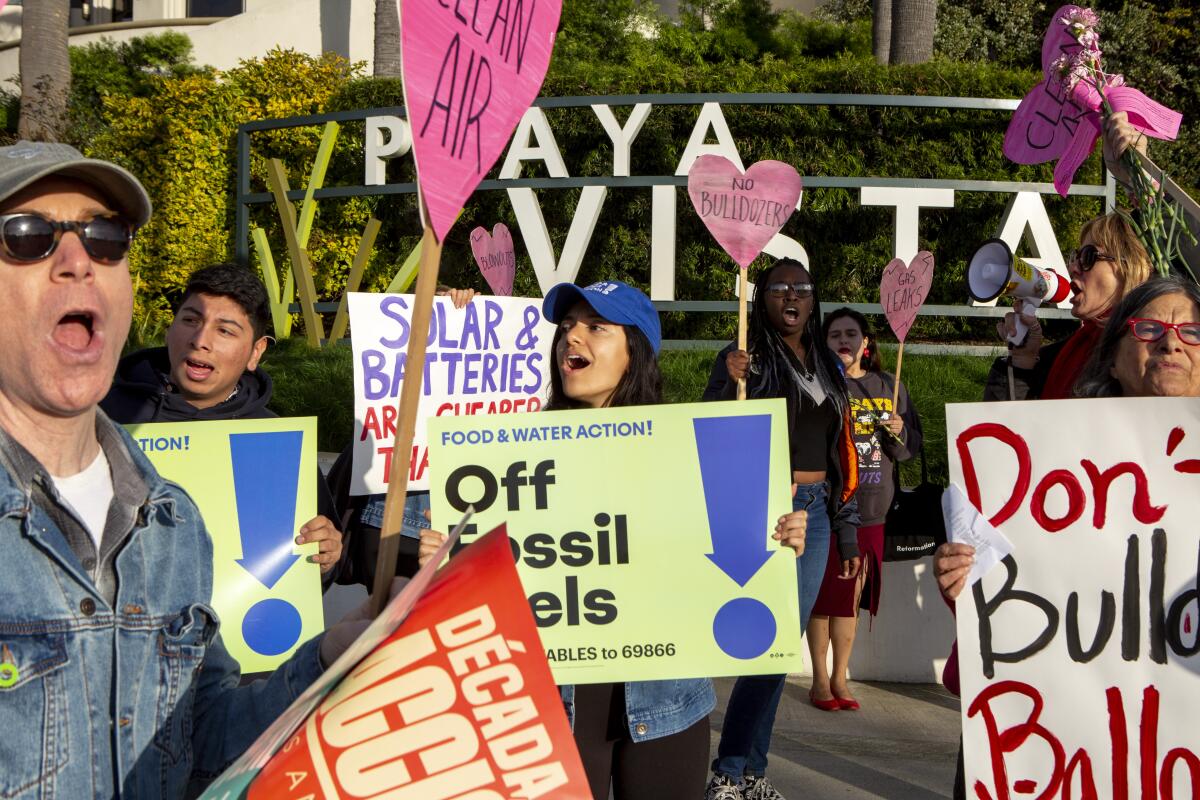
‘God put it here, and that’s it’
Concerns over SoCalGas’s presence in Playa del Rey are not new.
Thirty-one years ago, The Times reported that residents of the neighborhoods that had cropped up around the storage field since World War II — when gas was first pumped underground — regularly complained about odors and leaks. A SoCalGas official said at the time that the company could not move the facility because of its use of a naturally occurring underground oil field.
“God put it here, and that’s it. So we’ve got to live with the neighbors,” the official said.
The neighbors have had a lot to put up with.
A 2005 study found that gas “has been leaking along old wellbores for a number of years,” according to the California Council on Science and Technology. The council called it “a documented case of storage gas impacting a groundwater aquifer.”
Southern California Gas is engaged in a wide-ranging campaign to preserve the role of its pipelines in powering society.
Two years later, SoCalGas was sued by the Environmental Law Foundation, which alleged the company had “contaminated or threaten(ed) to contaminate” groundwater with cancer-causing chemicals by failing to contain the spread of its gas at Playa del Rey. SoCalGas settled the case, agreeing to increase monitoring and pay the foundation nearly $1 million in legal fees.
Attorney Jim Wheaton, who led the foundation at the time, remembers his staff scientist visiting the facility and telling him, “OMG. There’s natural gas coming to the surface. You can see it bubbling” in the marina and Ballona Creek.
In a settlement with the Grassroots Coalition in 2007, SoCalGas agreed to reduce emissions from Playa del Rey and make public more information about the chemical contents of its gas. That followed concerns raised by nearby residents that leaks or intentional venting could be poisoning the neighborhood’s air and soil.
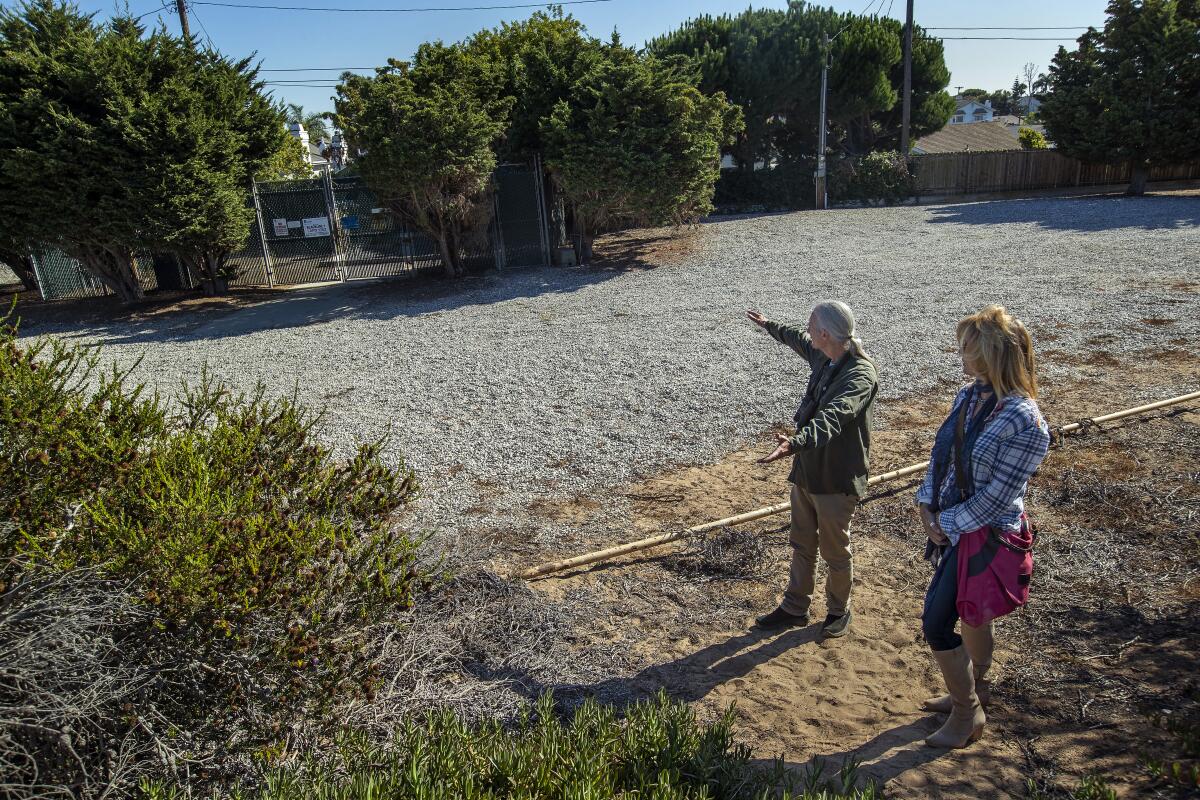
In March 2011, the state’s oil and gas regulator ordered SoCalGas to stop injecting gas at Playa del Rey for four months after problems were detected at several wells.
In January 2013, a gas explosion at the facility sent up a massive plume of flames that could be seen for miles.
The bluffs overlooking the Ballona Wetlands offer stunning views of the Westside, although it’s not hard to spot the gas well pads and compressor station just down the hill.
There are also several wells hidden in the neighborhood atop the bluffs, including two on otherwise empty lots surrounded by houses and partially hidden by trees. One has 107 homes within 200 meters, according to the Harvard study. Two more wells are located just beyond the outfield fence of a youth baseball field on SoCalGas property.
In Marina del Rey, there’s a well on a traffic island at the south end of Fiji Way, near Fisherman’s Village.
Anne Kirkpatrick has lived in the marina for nearly 30 years, down the block from the 2019 well blowout. Before that incident, she said, she had no idea she was living on top of an old oil field. She wants to see the SoCalGas facility shut down.
“People are concerned about their utility bills going up. I’d rather have a little bit higher of a utility bill than cancer,” she said.
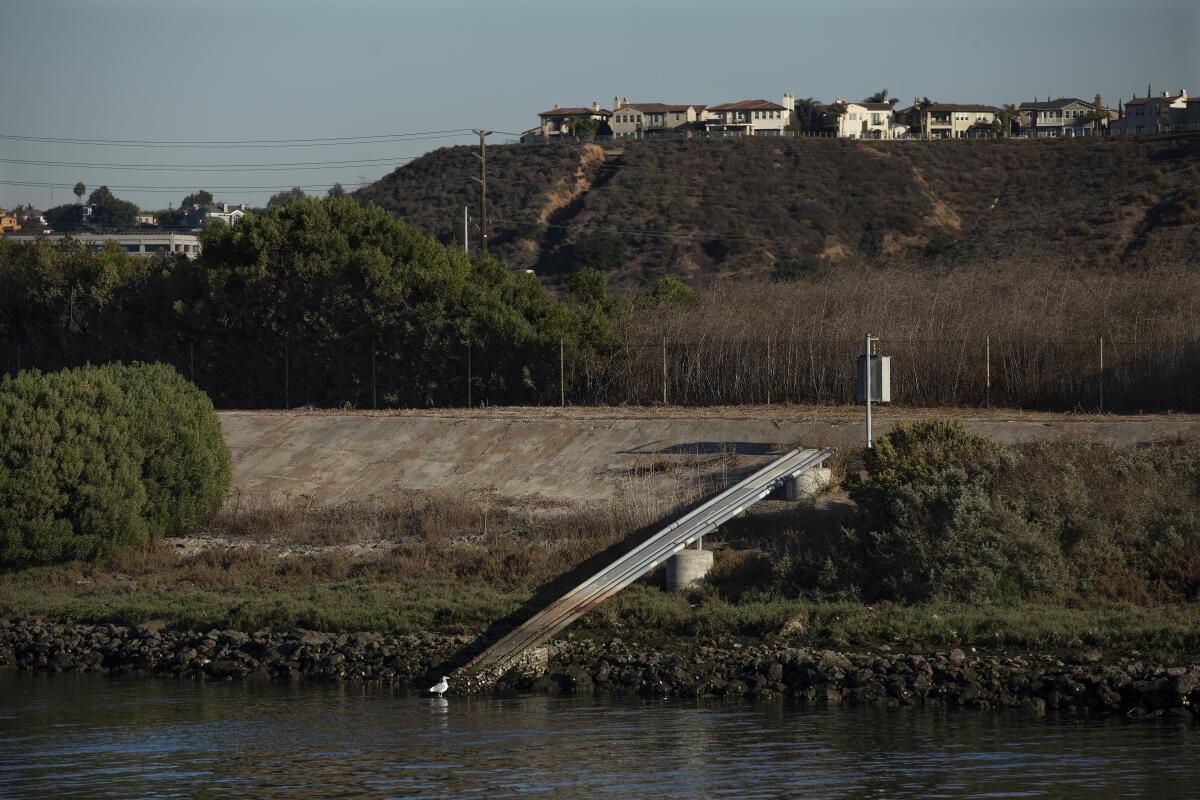
SoCalGas says its storage field poses no threat to Angelenos and has gotten safer since the Aliso Canyon leak.
In a recent presentation, John Thompson, the utility’s storage reservoir engineering manager, pointed to several improvements at Playa del Rey, including daily inspections, continuous methane monitoring and new steel inner tubing in every active well.
Thompson said the facility is crucial not only for sending gas to homes but for supplying industrial gas users. Playa del Rey serves several gas-fired power plants and oil refineries, including Chevron’s El Segundo refinery, the West Coast’s second largest.
“The facility may be small, but its location is very critical,” Thompson told Santa Monica’s environmental task force.
The gas company says its infrastructure can be repurposed to help fight climate change, with cleaner fuels subbing in for fossil gas. Clean energy activists are skeptical — renewable gas supplies will probably be relatively limited, and renewable hydrogen is largely unproven — but SoCalGas has used that argument to bolster its case for keeping gas storage fields open.
The company said last month it will aim for net-zero carbon emissions by 2045. Chief Executive Scott Drury wrote that California “can reach our climate goals and deliver reliable and affordable energy by accelerating the decarbonization of the gas system.”
SoCalGas has also highlighted its plans to remove more than a dozen wells that puncture the Ballona Wetlands Ecological Reserve. Work began last year, with construction crews beginning to remove the Vidor 5 observation well just off Culver Boulevard.
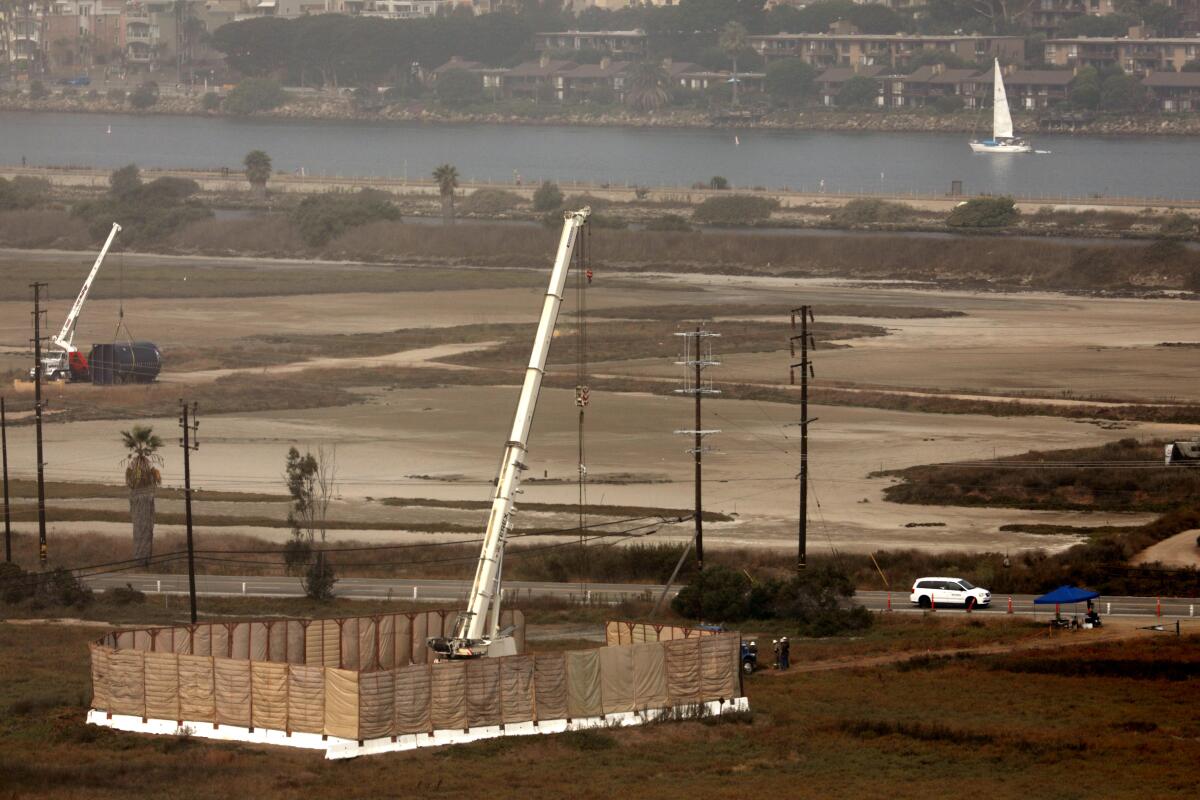
But the well removals have faced pushback from critics including Hanscom, who oppose the gas company’s plan to drill several new wells from its own property that would extend under the wetlands. The more money SoCalGas spends on new infrastructure at Playa, their thinking goes, the more reason it will have to fight for the facility’s continued operation long into the future.
“This is not the type of infrastructure that we should be investing more into,” Nancy Barba, who works for an energy efficiency company and serves on Culver City’s planning commission, said at a recent city council meeting.
Even some environmentalists who support the well removals say SoCalGas needs to go. Santa Monica-based Heal the Bay endorsed calls to shut down the Playa del Rey field last year, the same day it said it would stop accepting SoCalGas funding.
“I’m lumping them with oil companies now. The damage they do is just too great,” said Shelley Luce, the group’s chief executive.
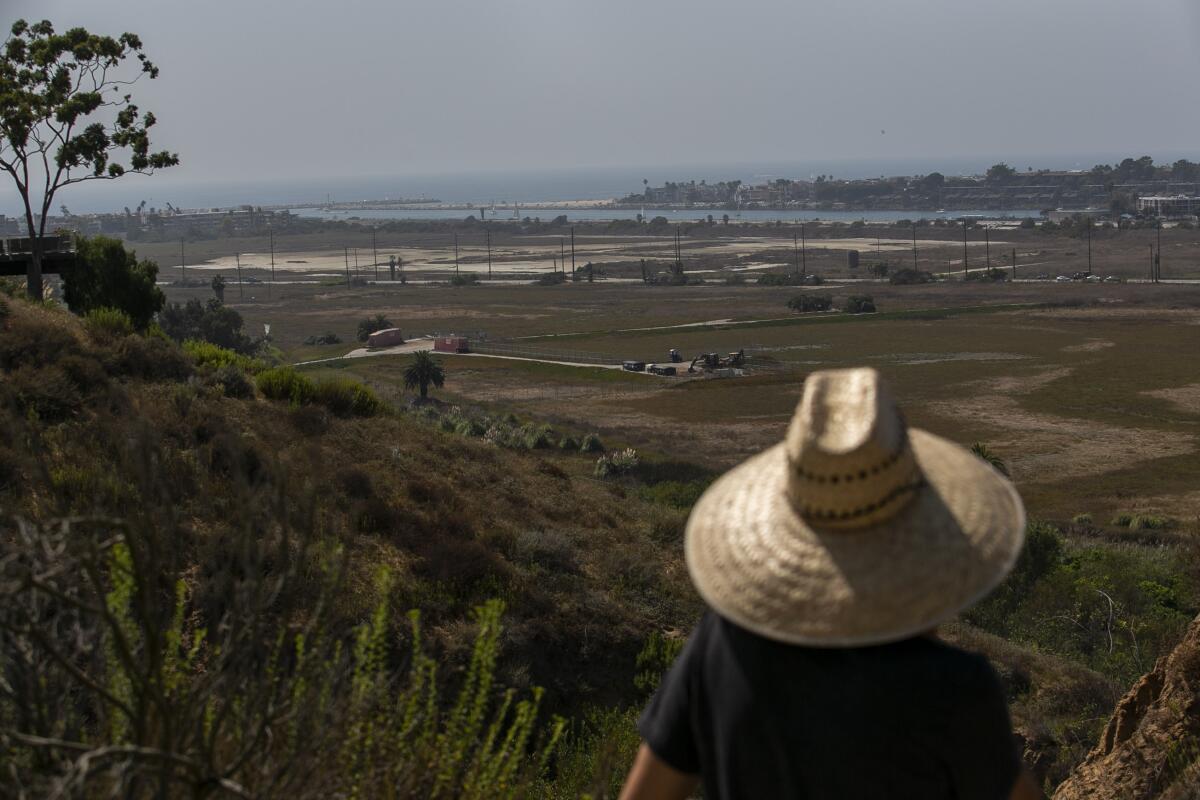
Taking California’s foot off the gas
Bonin, the L.A. City Council member, worries that a blowout at Playa del Rey similar to the one at Aliso Canyon could force the evacuation of hundreds of thousands of people and the temporary shutdown of LAX. He wrote to Newsom in May 2019, urging the governor to order a cost-benefit analysis evaluating closure of the Westside gas field. Two years later, that hasn’t happened.
“SoCalGas, they’re a great player in the community. They support a lot of great causes and organizations, everything from youth sports to community cleanups,” Bonin said in an interview. “But I don’t want to get that alert on my iPhone about a disaster, and have people’s life and safety imperiled and not have tried to do something about it in advance.”
“The climate crisis is getting exponentially worse in front of our eyes. And we know that the end of fossil fuels has to come,” he added. “So between the public safety risk and the fact that we have to get off fossil fuels, let’s just get moving.”
Support our journalism
Your support helps us deliver the news that matters most. Subscribe to the Los Angeles Times.
Shutting down gas storage fields is easier said than done in a state that relies on the fuel for one-third of its electricity and most of its space and hot water heating. And critics say Newsom and his appointees have done little to lessen the state’s reliance on gas.
The California Energy Commission is set to allow new homes to be built with gas appliances through at least 2025. The state water board extended the shutdown deadline for four gas-fired power plants last year out of fear of power outages.
Newsom took several big steps on climate last fall, ordering an end to the sale of gasoline-powered cars by 2035 and calling for lawmakers to ban fracking. But his climate package didn’t include anything to wean homes off gas heating and cooking.
“There’s a lot more work that needs to be done, and a lot more leadership that needs to be shown by Newsom,” said Alexandra Nagy, California director of Food & Water Watch, one of the groups campaigning to shut down the Playa del Rey gas field.
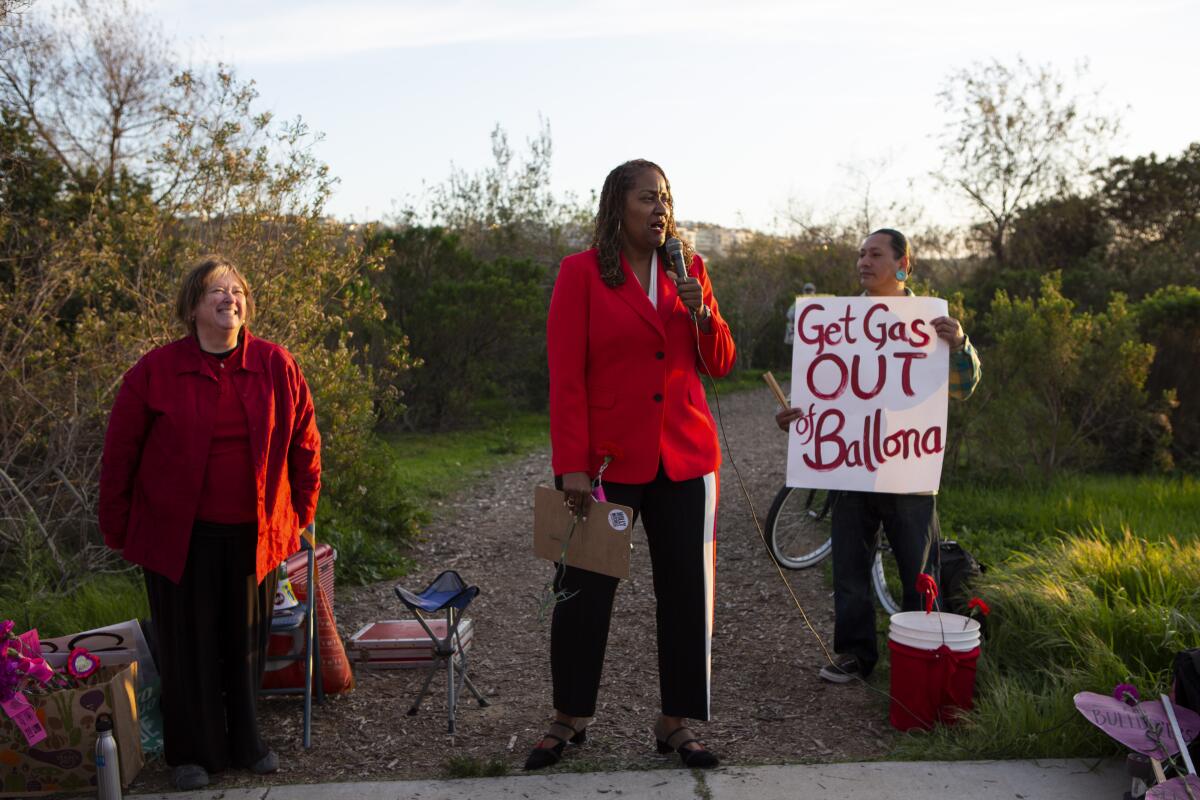
Newsom did tell the Public Utilities Commission to hurry its study of the feasibility of shutting down Aliso Canyon. But in the meantime, the commission may raise the cap on how much gas can be stored at Aliso, which has been limited since the methane leak to protect public health. A modeling report released by the agency in January assumes peak winter gas demand will fall by just 3% over the next decade — and peak summer demand will rise by nearly 5%.
“There are reliability risks to keeping Aliso Canyon inventory low,” commission spokesperson Terrie Prosper said in a written statement.
Asked for Newsom’s position on Playa del Rey, spokesperson Erin Mellon didn’t answer directly. She said his administration is “working to get to a carbon-neutral economy by 2045 and believes the need for natural gas storage may look very different in that future.”
California’s governor called record-breaking heat and wildfires a “climate damn emergency.” But actions speak louder than words.
Newsom visited the Ballona Wetlands while running for governor, less than a year before the gas geyser that sent a worker scrambling for safety. Two Marriott hotels are now taking reservations at the site. There’s no sign the blowout happened.
There is a small wetland park, which L.A. County required the hotel developer to help fund. It’s a reminder of the ecosystems that were lost when Playa Vista was built, Ballona Creek was encased in concrete and the landscape was shot through with oil wells.
Activists hope that the fossil fuel infrastructure, at least, can become the stuff of history.
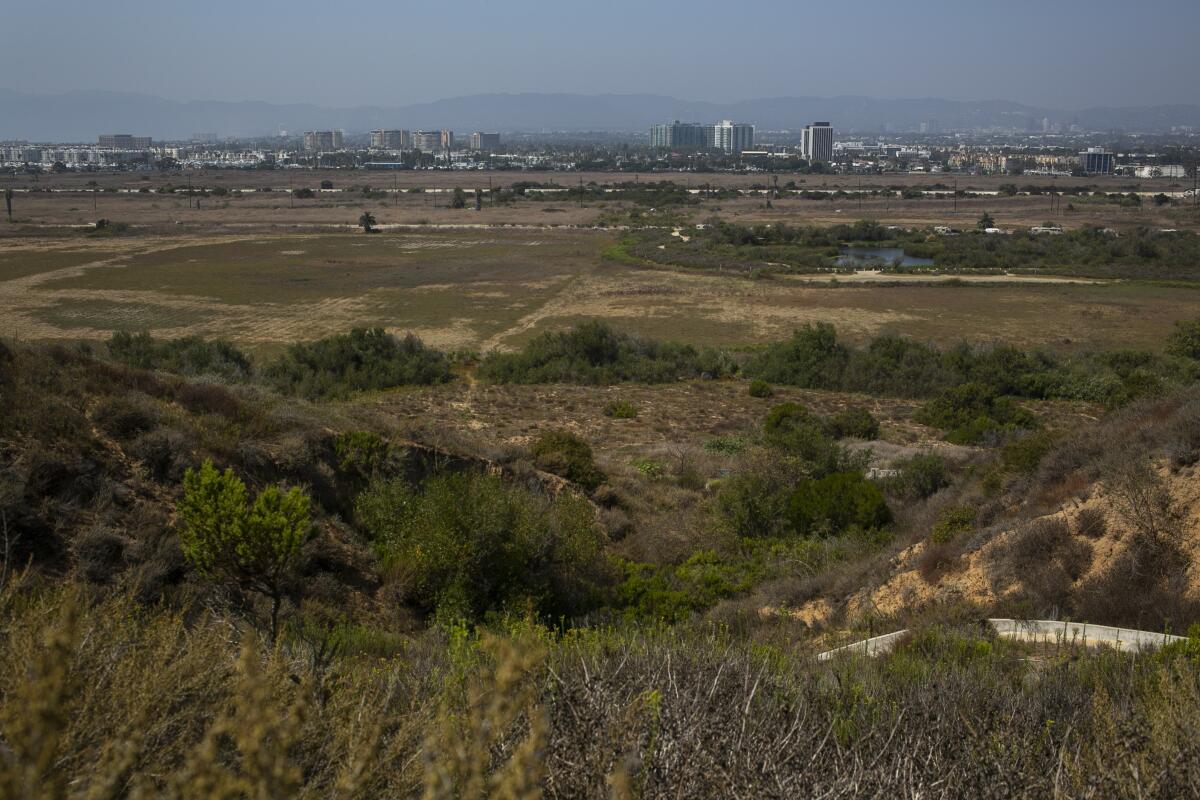
More to Read
Toward a more sustainable California
Get Boiling Point, our newsletter exploring climate change, energy and the environment, and become part of the conversation — and the solution.
You may occasionally receive promotional content from the Los Angeles Times.
